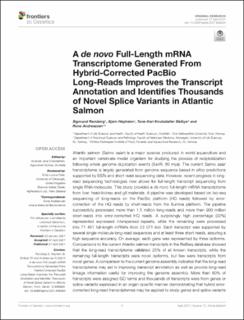| dc.contributor.author | Ramberg, Sigmund | |
| dc.contributor.author | Bjørn, Høyheim | |
| dc.contributor.author | tone-kari, knutsdatter østbye | |
| dc.contributor.author | Andreassen, Rune | |
| dc.date.accessioned | 2021-09-22T13:05:52Z | |
| dc.date.available | 2021-09-22T13:05:52Z | |
| dc.date.created | 2021-05-19T10:11:53Z | |
| dc.date.issued | 2021-04-27 | |
| dc.identifier.citation | Frontiers in Genetics. 2021, 12 (656334), 1-22. | en_US |
| dc.identifier.issn | 1664-8021 | |
| dc.identifier.uri | https://hdl.handle.net/11250/2780352 | |
| dc.description.abstract | Atlantic salmon (Salmo salar) is a major species produced in world aquaculture and an important vertebrate model organism for studying the process of rediploidization following whole genome duplication events (Ss4R, 80 mya). The current Salmo salar transcriptome is largely generated from genome sequence based in silico predictions supported by ESTs and short-read sequencing data. However, recent progress in long-read sequencing technologies now allows for full-length transcript sequencing from single RNA-molecules. This study provides a de novo full-length mRNA transcriptome from liver, head-kidney and gill materials. A pipeline was developed based on Iso-seq sequencing of long-reads on the PacBio platform (HQ reads) followed by error-correction of the HQ reads by short-reads from the Illumina platform. The pipeline successfully processed more than 1.5 million long-reads and more than 900 million short-reads into error-corrected HQ reads. A surprisingly high percentage (32%) represented expressed interspersed repeats, while the remaining were processed into 71 461 full-length mRNAs from 23 071 loci. Each transcript was supported by several single-molecule long-read sequences and at least three short-reads, assuring a high sequence accuracy. On average, each gene was represented by three isoforms. Comparisons to the current Atlantic salmon transcripts in the RefSeq database showed that the long-read transcriptome validated 25% of all known transcripts, while the remaining full-length transcripts were novel isoforms, but few were transcripts from novel genes. A comparison to the current genome assembly indicates that the long-read transcriptome may aid in improving transcript annotation as well as provide long-read linkage information useful for improving the genome assembly. More than 80% of transcripts were assigned GO terms and thousands of transcripts were from genes or splice-variants expressed in an organ-specific manner demonstrating that hybrid error corrected long-read transcriptomes may be applied to study genes and splice-variants expressed in certain organs or conditions (e.g., challenge materials). In conclusion, this is the single largest contribution of full-length mRNAs in Atlantic salmon. The results will be of great value to salmon genomics research, and the pipeline outlined may be applied to generate additional de novo transcriptomes in Atlantic Salmon or applied for similar projects in other species. | en_US |
| dc.description.sponsorship | This study was funded by Norwegian Research Council Grant to RA (280839/E40). | en_US |
| dc.language.iso | eng | en_US |
| dc.publisher | Frontiers Media | en_US |
| dc.relation.ispartofseries | Frontiers in Genetics;April 2021 | Volume 12 | Article 656334 | |
| dc.rights | Navngivelse 4.0 Internasjonal | * |
| dc.rights.uri | http://creativecommons.org/licenses/by/4.0/deed.no | * |
| dc.subject | Atlantic salmon | en_US |
| dc.subject | Transcriptomes | en_US |
| dc.subject | Full-length mRNAs | en_US |
| dc.subject | Hybrid error corrections | en_US |
| dc.subject | PacBio Iso-sequences | en_US |
| dc.subject | Illumina sequencing | en_US |
| dc.title | A de novo Full-Length mRNA Transcriptome Generated From Hybrid-Corrected PacBio Long-Reads Improves the Transcript Annotation and Identifies Thousands of Novel Splice Variants in Atlantic Salmon | en_US |
| dc.type | Peer reviewed | en_US |
| dc.type | Journal article | en_US |
| dc.description.version | publishedVersion | en_US |
| dc.rights.holder | Copyright © 2021 Ramberg, Høyheim, Østbye and Andreassen. | en_US |
| dc.source.articlenumber | 656334 | en_US |
| cristin.ispublished | true | |
| cristin.fulltext | original | |
| cristin.qualitycode | 1 | |
| dc.identifier.doi | https://doi.org/10.3389/fgene.2021.656334 | |
| dc.identifier.cristin | 1910692 | |
| dc.source.journal | Frontiers in Genetics | en_US |
| dc.source.volume | 12 | en_US |
| dc.source.pagenumber | 1-22 | en_US |
| dc.relation.project | Norges forskningsråd: 280839 | en_US |

